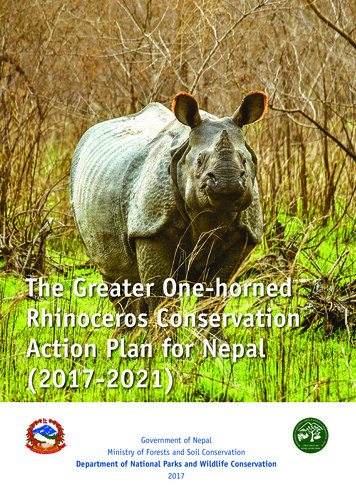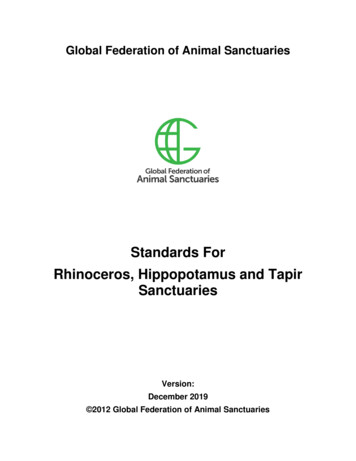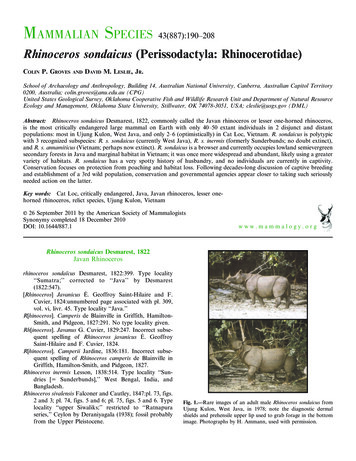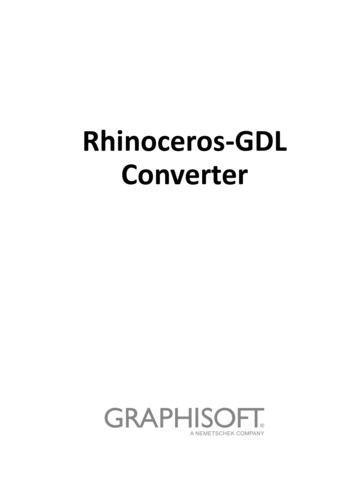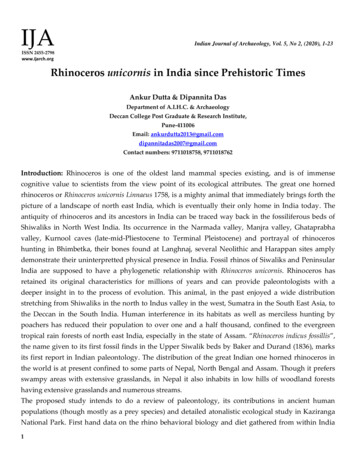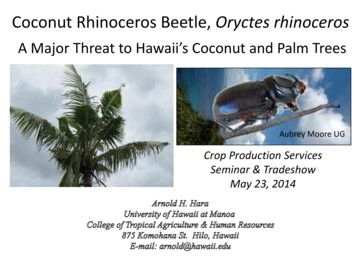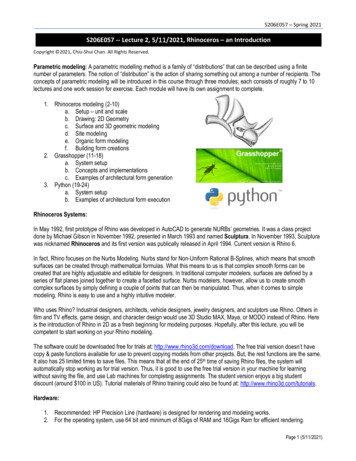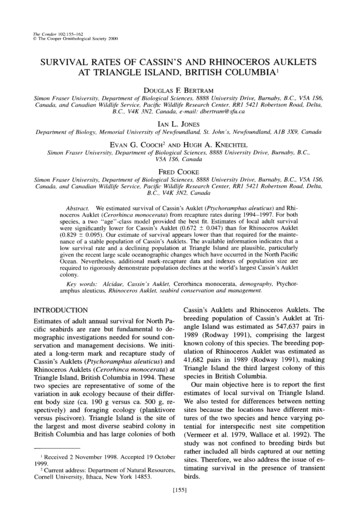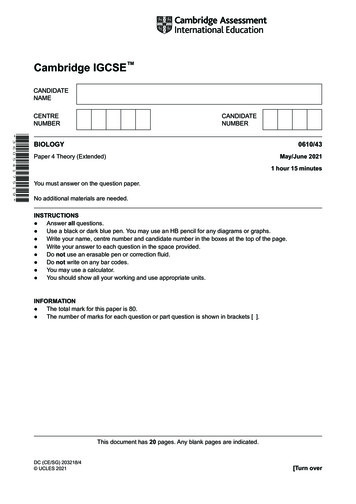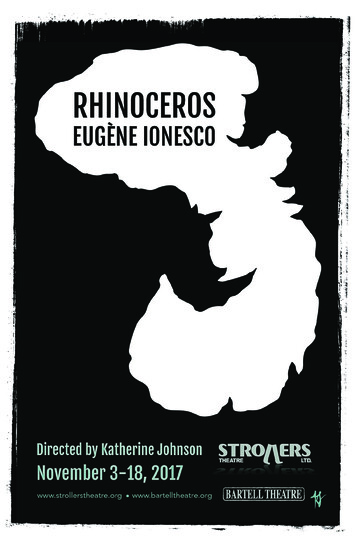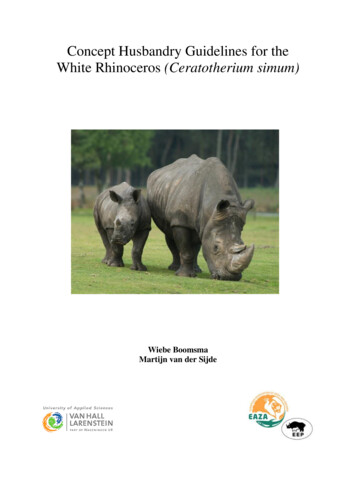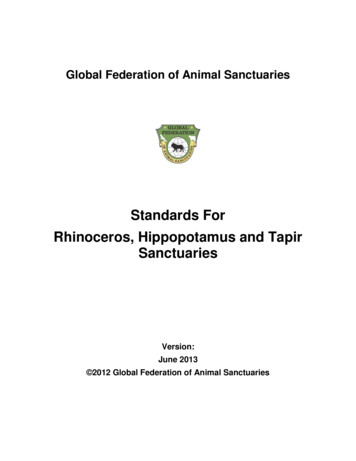
Transcription
Global Federation of Animal SanctuariesStandards ForRhinoceros, Hippopotamus and TapirSanctuariesVersion:June 2013 2012 Global Federation of Animal Sanctuaries
Global Federation of Animal Sanctuaries – Standards for Rhinoceros, Hippopotamus and TapirSanctuariesTable of ContentsINTRODUCTION . 1GFAS PRINCIPLES . 1ANIMALS COVERED BY THESE STANDARDS . 1STANDARDS UPDATES . 2RHINOCEROS, HIPPOPOTAMUS AND TAPIR STANDARDS . 2RHINOCEROS, HIPPOPOTAMUS AND TAPIR HOUSING. 3H-1. Types of Space and Size . 3H-2. Containment . 5H-3. Ground and Plantings . 7H-4. Transfer Doors . 9H-5. Shelter. 10H-6. Enclosure Furniture . 10H-7. Sanitation . 11H-8. Temperature, Humidity, Ventilation, Lighting . 12PHYSICAL FACILITIES AND ADMINISTRATION . 14PF-1. Overall Safety of Facilities . 14PF-2. Water Drainage and Testing . 14PF-3. Life Support . 14PF-4. Hazardous Materials Handling . 15PF-5. Security: Rhinoceros, Hippopotamus and Tapir Enclosures . 15PF-6. Perimeter Boundary and Inspections, and Maintenance . 16PF-7. Security: General Safety Monitoring . 16PF-8. Insect and Rodent Control . 18PF-9. Record Keeping . 18PF-10. Animal Transport . 19NUTRITION REQUIREMENTS . 20N-1. Water . 20N-2. Diet . 21N-3. Food Presentation and Feeding Techniques . 22N-4. Food Storage . 23N-5. Food Handling . 23VETERINARY CARE . 24V-1. General Medical Program and Staffing . 24V-2. On-Site and Off-Site Veterinary Facilities . 24V-3. Preventative Medicine Program . 25V-4. Clinical Pathology, Surgical, Treatment and Necropsy Facilities . 26V-5. Quarantine and Isolation of Rhinoceros, Hippopotamus and Tapirs. 27i
Global Federation of Animal Sanctuaries – Standards for Rhinoceros, Hippopotamus and TapirSanctuariesV-6. Medical Records and Controlled Substances. 28V-7. Breeding/Contraception . 29V-8. Zoonotic Disease Program . 30WELL-BEING AND HANDLING OF RHINOCEROS, HIPPOPOTAMUS AND TAPIRS . 30W-1. Physical Well-Being . 30W-2. Social Housing . 31W-3. Introduction of Unfamiliar Individuals . 31W-4. Behavioral/Psychological Well-Being . 33Rhinoceros/Hippopotamus/Tapir-Caregiver Relationships . 33W-5. Handling and Restraint . 34STAFFING . 35GENERAL STAFFING. 35S-1. General Staffing Considerations . 35S-2. Security and Emergency Coverage . 36S-3. Volunteer and Internship Programs . 36S-4. Manuals . 36S-5. Employee Training and Continuing Education . 37SAFETY POLICIES, PROTOCOLS AND TRAINING . 37S-6. General Staff Safety . 37S-7. Communication System . 38S-8. Emergency Response Plans and Protocols . 38S-9. Escaped Rhinoceros, Hippopotamus and Tapir Protocol. 39S-10. Emergency Training . 39S-11. Firearm Policy . 40S-12. Firearm Training . 40S-13. Chemical Restraint . 40S-14. First Aid and Zoonotic Disease Training, and Staff First Aid . 41GOVERNANCE AND FINANCE . 41GOVERNING AUTHORITY . 41G-1. Nonprofit/ Non-Commercial Status . 41G-2. Ownership of Sanctuary Property and Contingency Planning . 42G-3. Succession Planning . 42G-4. Board of Directors/Trustees . 43G-5. Ethics and Grievance Procedures. 43G-6. Required Licenses and Permits . 44G-7. Strategic Planning. 44FINANCIAL RECORDS AND STABILITY . 44F-1. Budget and Financial Plan . 44F-2. Financial Reports . 45F-3. Financial Stability . 45F-4. Banking Responsibilities and Financial Transactions . 45ii
Global Federation of Animal Sanctuaries – Standards for Rhinoceros, Hippopotamus and TapirSanctuariesF-5. Fundraising Activities and Disclosures . 46F-6. Insurance and Waivers . 46EDUCATION AND OUTREACH . 47E-1. Education Programs . 47E-2. Tours . 47E-3. Outreach. 48POLICIES . 48POLICIES: ACQUISITION AND DISPOSITION OF RHINOCEROS, HIPPOPOTAMUS AND TAPIRS . 48P-1. Acquisition Ethics and Commercial Trade Prohibition . 48P-2. Acquisition Recordkeeping and Monetary Exchange . 49P-3. Disposition Ethics and Responsibility . 49P-4. Disposition of Live Rhinoceros, Hippopotamus and Tapirs . 50P-5. Euthanasia . 50POLICIES: PUBLIC CONTACT AND RESTRICTIONS ON USE AND HANDLING OF RHINOCEROS, HIPPOPOTAMUS ANDTAPIRS. 51P-6. Public Contact . 51P-7. Removal from Sanctuary or Enclosures/Habitats for Non-Medical Reasons . 51P-8. Public Viewing of Human/Animal Interaction. 53P-9. Non-Portrayal of Rhinoceros, Hippopotamus and Tapirs as Tractable . 53P-10. Non-Harmful, Non-Exploitive Fundraising . 53P-11. Ethics in Research . 54RHINOCEROS, HIPPOPOTAMUS AND TAPIR BEING RELEASED TO THE WILD . 54R-1. General Considerations . 55R-2. Rescue Of Rhinoceros, Hippopotamus and Tapirs . 55R-3. Evaluation Of Suitability For Release . 56R-4. Quarantine And Prerelease Housing . 56R-5. Diet, Nutrition And Foraging Skills . 58R-6. Husbandry And Health . 59R-7. Health And Safety Of Caregivers Working With Releasable Rhinoceros, Hippopotamus and Tapirs . 60R-8. Assessment of Health and Skills . 60R-9. Determining Appropriate Release Sites . 60R-10. The Release Process And Post Release Monitoring . 60APPENDIX 1 . 62iii
Global Federation of Animal Sanctuaries – Standards for Rhinoceros, Hippopotamus and TapirSanctuariesINTRODUCTIONGFAS PRINCIPLESThe Global Federation of Animal Sanctuaries (GFAS) will designate an organization as “verified” or“accredited” based upon its substantial compliance with the standards listed below. GFAS recognizes thatsome organizations under consideration will operate valid rescue and rehabilitation programs with a goalof releasing wildlife to the wild pursuant to IUCN and/or other international or national standards. Forthose animals, lifetime sanctuary care may not be part of the organization’s mission. While the care forthese animals may be provided on an interim basis only, the organization is still expected to meet thestandards below with regard to all animals in its care and for purposes of these standards it will beidentified as a “sanctuary.”Consistent with GFAS’ philosophy and the standards below, it is expected that a sanctuary does notadopt policy positions that are in opposition to the welfare of the species of animals in the care of thesanctuary (for example, while it is not required that a primate sanctuary affirmatively promote a policyagainst laboratory research using primates, it should not promote a policy in favor of such research).Note: Several standards make reference to a sanctuary’s “Director.” GFAS recognizes that a sanctuarymay use a different title, and the term “Director” is intended to reference the sanctuary’s SanctuaryDirector, who may be called an Executive Director or Chief Executive Officer, etc.GFAS also recognizes that sanctuaries may rely on volunteers for certain functions, including someaspects of animal care (such as food preparation). Standards referencing “staff” may take into accountappropriately qualified and trained volunteers as well as employees.Appendix I of this document provides further guidance/suggestions on facility design and rhinoceros,hippopotamus and tapir care. These are not requirements but rather provide sanctuaries with access toknowledge gained from experience at other sanctuaries/rhinoceros, hippopotamus and tapir carefacilities.ANIMALS COVERED BY THESE STANDARDSFamily/Genus/ Species/Common NamesFamily: Hippopotamidae, Rhinocerotidae, nicornisTapirusTapirusbairdiiindicusCommon Namewhite rhinoceros, northern white rhinoceros, square-lippedrhinocerospygmy hippo, pygmy hippopotamusSumatran rhinocerosblack rhinoceros, hook-lipped rhinoceroshippopotamus, hippo, large hippoJavan rhinocerosIndian rhinoceros, greater one-horned rhino, Greater IndianrhinocerosBaird’s tapir, Central American tapirAsian tapir, Indian tapir, Malayan tapir, Malay tapir1
Global Federation of Animal Sanctuaries – Standards for Rhinoceros, Hippopotamus and ountain tapir, Andean tapir, woolly tapirlowland tapir, Brazilian tapir, South American tapirVersion Updates:New and Updated content released on February 2015 G-1 Nonprofit/ Non-Commercial Status, P-3 Disposition Ethics and Responsibility, P-4Disposition of Live Rhinos, Hippos, and Tapirs, P-5 EuthanasiaNew and Changed content released on July 2015 V-7 Breeding/Contraception – section a.2
Global Federation of Animal Sanctuaries – Standards for Rhinoceros, Hippopotamus and TapirSanctuariesRHINOCEROS, HIPPOPOTAMUS AND TAPIR STANDARDSGFAS notes that there may be other acceptable ways of meeting the intent of each standard, aside fromthose detailed below, and that in some instances there may be legal, cultural or other significant barriersto meeting GFAS requirements. The standards are considered mandatory, but GFAS will considerspecific exceptions to some of the listed requirements (e.g., exact enclosure size, manner of recordkeeping, legal requirements that impact a sanctuary’s acquisition policy, etc.). GFAS encouragessanctuaries to offer feedback on the standards and to explain any reasons why it believes it cannot meeta particular standard, or why the standard is not applicable and/or appropriate to its situation. Sanctuariesare also welcome to indicate a timeline for meeting a standard if the standard is not yet met at the time ofapplication for accreditation or for verification.The exceeding of the standards is encouraged. In addition to meeting these standards, an organization isexpected to comply with all applicable international, national, state/province, and local laws andregulations.RHINOCEROS, HIPPOPOTAMUS AND TAPIR HOUSINGH-1. Types of Space and SizeUnless otherwise directed by a veterinarian, rhinos, hippos and tapirs are providedsufficient opportunity and space to move about freely and rapidly, and to exercisechoice in location so as to reduce stress and maintain good physical condition.Generala. The habitat and living conditions are species appropriate and replicate, in as much as possible, therhino, hippo and tapir wild habitat with a balance between hygiene and the species’ physiological andpsychological needs. This includes adequate and appropriate space, in terms of diversity andcomplexity.b. The physical space provides varied opportunities for the rhinos, hippos and tapirs to interact with theenvironment and key elements are changed often, resulting in a dynamic living space.c.Facility design takes into account caregiver-animal safety and ease of maintaining a positiverelationship.d. Rhinos, hippos and tapirs are provided access to as many areas of the enclosures as possible,except during staff maintenance activities, unless security concerns dictate otherwise. All enclosuresinterconnect without creating 'dead ends' to allow for freedom of movement of subordinateindividuals.e. Outdoor enclosures are either covered, with minimum height to allow for natural behaviors, or openroofed with sufficient height to prevent escape (see Housing Dimensions for appropriatemeasurements).f.The habitat provides appropriate visual, olfactory, and acoustic barriers.g. The habitat provides security from predators and unauthorized human access.Open Space Settingsh. Open space enclosures, which may be indoor or outdoor units, are designed to provide the maximumpossible freedom and complexity for enclosure residents. The enclosures have sufficient area per3
Global Federation of Animal Sanctuaries – Standards for Rhinoceros, Hippopotamus and TapirSanctuariesanimal to accommodate natural individual and group activities. While it may not be possible tomonitor every animal in an Open Space enclosure on a daily basis, design allows for regularinspection of animals and facility maintenance as needed.i.Where open space settings are the primary enclosure, the following are also provided: Shelter which can serve as night housing and/or secure space during inclement and extremeweather. Space for use while the primary enclosure is serviced and/or for animal management needsincluding introduction of new individuals to a group, or temporary separation for health or socialreasons. (Note: This space might also be night housing, lockout, shift yard, etc.) Alternate housing for sick or injured individuals.Controlled access settingsj.Controlled access enclosures, which may be indoor or outdoor units, provide sufficient space fornatural activities but are also designed to allow caregivers to monitor each individual animal on a dailybasis, to easily shift individuals, pairs or small groups as needed and to isolate animals for individualcare. As with Open Space enclosures, design also includes: Shelter which can serve as night housing and/or secure space during inclement and extremeweather. Space for use while the primary enclosure is serviced and/or for animal management needsincluding introduction of new individuals to a group, or temporary separation for health or socialreasons. (Note: This space might also be night housing, lockout, shift yard, etc.) Alternate housing for sick or injured individuals.Indoor Housingk.Indoor housing provides year-round protection from the elements. For sanctuaries located in colderclimates (where freezing temperatures occur regularly during any part of the year and temperate ortropical species are housed), indoor space is insulated and is large enough to allow for all forms ofspecies-specific behavior (running, swimming, digging/wallowing, playing, etc.).Dimensionsl.Many factors influence the minimum space required for a group of rhinoceros, hippopotamus ortapirs, including, but not limited to: group size, group composition, and enclosure complexity. Thefollowing guidelines are minimum recommendations. Facilities should provide as much space as ispossible and/or practical.m. Sanctuaries meeting only the minimum requirements for enclosure space employ additionalenvironmental enrichment, focusing on physical and mental exercise rather than food, to compensatefor reduced space and complexity. The use of a rotation system, which allows groups and/or individual rhinos, hippos and tapirs toregularly spend time in a larger or different space, is strongly encouraged in these circumstancesto increase enrichment and encourage activity. Outdoor enclosures for rhinoceros, hippopotamus and tapirs - Enclosure shape may be variableto take in natural features in the landscape such as rock formations, hills and trees. Particularattention is paid to providing water features such as mud wallows, ponds and/or pools, forthermoregulation and enrichment. Space includes a minimum of one (1) animal transfer doorleading to indoor shelter.oMinimum of 10,000 sq. ft. (929 sq. m) per adult rhinoceros/hippopotamus.oMinimum of 3,230 sq. ft. (300 sq. m) per pair of adult tapir/pygmy hippo.4
Global Federation of Animal Sanctuaries – Standards for Rhinoceros, Hippopotamus and TapirSanctuariesoMinimum vertical dimension of 5 ft. (1.5 m) for all species.n. Indoor enclosures/shift yards for rhinoceros, hippopotamus and tapirs - A minimum of two indoorareas or one indoor enclosure and one shift yard per adult rhino or hippo or pair of adult tapir orpygmy hippo, with a minimum of two doors to adjacent enclosures. Room dimension is dependent onintended purpose and/or duration of confinement. Space includes water features for animals beinghoused long term. Includes two rooms or one room and a shift yard with minimum dimensions of 2000 sq. ft. (92.9sq.m) per adult rhinoceros or hippopotamus. Includes two rooms or one room and a shift yard with minimum dimensions of 538 sq. ft. (50 sq.m) per pair of adult tapirs or pygmy hippopotamus. Rooms and shift yards interconnect without creating ‘dead ends’ to allow for freedom ofmovement for subordinate individuals and include a minimum of two transfer doors per room/shiftyard to the main outdoor enclosure. Where animals are housed indoors long term, e.g. in northern climates where freezingtemperatures occur regularly, indoor space is large enough to accommodate all forms of speciesspecific behavior (running, wading/wallowing, swimming, etc.) Rhinoceros, hippopotamus and tapirs may be familiarized with rooms and shift yards throughroutine feeding in or transfer through, or by being allowed continuous access. Whenever possible and species appropriate, separated animals have visual and tactile access togroup members to facilitate reintroduction.o. Mixed species housing Where multiple species share an enclosure, the total dimension is adjusted to reflect theminimum spatial requirements of each species housed. Minimum indoor dimensions remain unchanged for each species. Each species has a dedicated transfer door between indoor and outdoor enclosures. Mixed species groupings are appropriately researched to ensure compatibility and to avoidunnecessary stress for all species.H-2. ContainmentRhinoceros, hippopotamus and tapirs are safely contained.Generala. Other than when being transported or for medical reasons, rhinos, hippos and tapirs are kept at alltimes in secure enclosures or other appropriate areas.b. Enclosures are designed to allow for animals ' normal defense reactions and appropriate 'flight' orescape distances.c.All enclosures are designed, constructed and maintained to securely contain rhinos, hippos and tapirsand to present no likelihood of harm to them.d. Distance or barriers between animals and between enclosures and personnel is sufficient to minimizestress to the animals, as well as reduce the risk of disease transmission. Clear markings delineating safe zones or transparent barrier such as plexiglass or lexan are usedin areas where caregivers must work in close proximity to cages.5
Global Federation of Animal Sanctuaries – Standards for Rhinoceros, Hippopotamus and TapirSanctuariese. Enclosures are designed to allow for proper, safe cleaning and drainage.f.Materials are appropriate for their particular application and ar
Global Federation of Animal Sanctuaries – Standards for Rhinoceros, Hippopotamus and Tapir Sanctuaries 2 Tapirus pinchaque mountain tapir, Andean tapir, woolly tapir Tapirus terrestris lowland tapi
